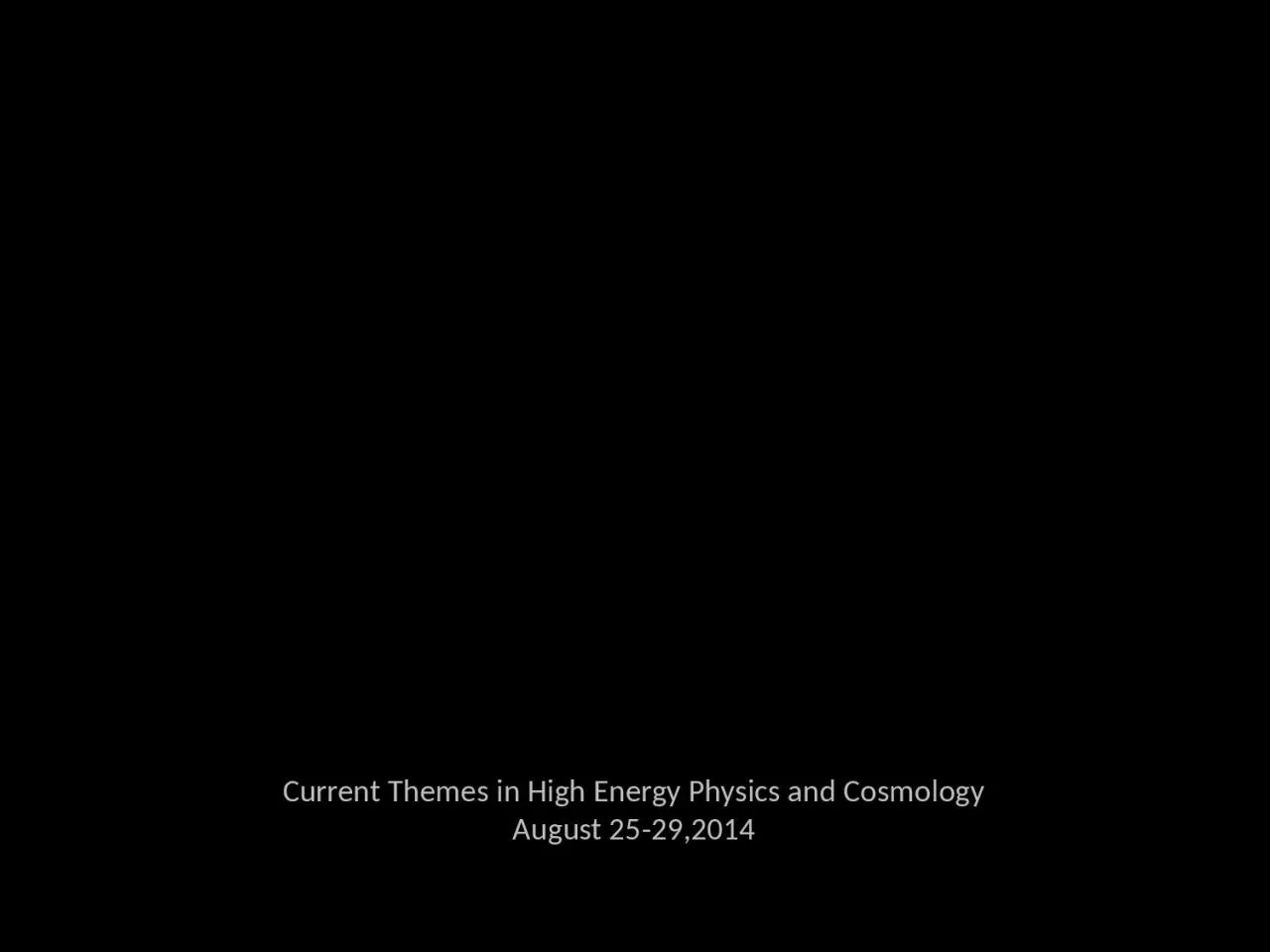

August 25292014 Recent Progress on Cosmological Bounces amp Bouncing Cosmologies Current Themes in High Energy Physics and Cosmology August 25292014 BICEP2 The null hypothesis lensing dust cannot be rejected ID: 1031548
Download Presentation The PPT/PDF document "Current Themes in High Energy Physics an..." is the property of its rightful owner. Permission is granted to download and print the materials on this web site for personal, non-commercial use only, and to display it on your personal computer provided you do not modify the materials and that you retain all copyright notices contained in the materials. By downloading content from our website, you accept the terms of this agreement.
1. Current Themes in High Energy Physics and CosmologyAugust 25-29,2014
2. Recent Progress onCosmological Bounces & Bouncing CosmologiesCurrent Themes in High Energy Physics and CosmologyAugust 25-29,2014
3. BICEP2The null hypothesis – lensing + dust – cannot be rejectedAny claim of tensor, esp. “r=0.2”, makes no sense scientificallyNo systematics paper Planck dust map available on September Nth, where N < 4
4. Typical initial conditionsSimple inflaton potentials with minimum tuning inflation smooth and flat universe + predictions of ns, a, nt, r, …“Classic” Inflationary PictureGuth, Kaiser, Nomura, PLB (2014)Linde, arxiv1402.0526 (2014) Ijjas, PJS. Loeb, PLB (2013, 2014) outdated
5. Typical initial conditionsSimple inflaton potentials with minimum tuning inflation smooth and flat universe + predictions of ns, a, nt, r, …Guth, Kaiser, Nomura, PLB (2014)Linde, arxiv1402.0526 (2014) Ijjas, PJS. Loeb, PLB (2013, 2014) An Alternative Inflationary Picture?
6. Typical initial conditionsGuth, Kaiser, Nomura, PLB (2014)Linde, arxiv1402.0526 (2014) Ijjas, PJS. Loeb, PLB (2013, 2014) An Alternative Inflationary Picture?
7. Typical initial conditionsSimple inflaton potentials with minimum tuning inflation smooth and flat universe + predictions of ns, a, nt, r, …Guth, Kaiser, Nomura, PLB (2014)Linde, arxiv1402.0526 (2014) Ijjas, PJS. Loeb, PLB (2013, 2014) An Alternative Inflationary Picture?
8. Typical initial conditionsSimple inflaton potentials with minimum tuning inflation smooth and flat universe + predictions of ns, a, nt, r, …Guth, Kaiser, Nomura, PLB (2014)Linde, arxiv1402.0526 (2014) Ijjas, PJS. Loeb, PLB (2013, 2014) multiverseAn Alternative Inflationary Picture?
9. Khoury, Ovrut, PJS, Turok (2001)PUS & Turok (2002)Why Bounce?
10. simple solution to flatness & homogeneity problemsinhomogeneitiesWhy Bounce?See also Xue et al, PRD88, 083509 (2013)
11. simple solution to flatness & homogeneity problemsWhy Bounce?evades the multiverse/unpredictability problemcan be made geodesically complete
12. Bouncing Fears?branes & extra dimensions?Khoury, Ovrut, PJS & Turok (2002)no-go thm: background must be unstable if it produces scale-invariant spectrum?Wesley & Tolley (2007)no-go thm: cannot produce adiabatic spectrum (directly)Creminelli, Nicolis, Zaldarriaga (2007)fNL ~ O(10)Lehners et al (2007); Finelli (2002)no theory for the bounce/incompatible with string theory
13. Ekpyrotic: ultra-slow contraction – a(t)~(-t)1/e < < 1/3VfTwo fields w/stable attractor solution 2nd field: centropic pert’s curvature Li, PLB 724 (2014)Fertig, Lehners, Mallwitz, PRD 89 (2014) Ijjas, PJS. Lehners, PRD 89, (2014) from conversion only:fNL ~ O(few)
14. Anamorphic: scalar-tensor + ordinary contractionIjjas, PJS. Lehners, to appear, (2014) but
15. Key differences from ekpyrotic:single fieldadiabatic directly (no conversion needed) Can adjust x and n to get ns=0.96 and r ~0.1fNL ~ O(1) Ijjas, PJS. Lehners, to appear, (2014) Li, PLB (2014) Anamorphic: scalar-tensor + ordinary contraction
16. What about the bounce?non-singular vs. singular Bars, PJS & Turok, Fortsh Phys, to appear (2014); Bars, PJS & Turok, PRD 89, 061302 (2014);Bars, PJS & Turok, PLB276, 50 (2013); Bars, PJS & Turok, PRD 89, 043515 (2014); Bars, Chen, PJS & Turok, PRD 86, 083542 (2012); Bars, Chen, PJS & Turok, PLB 715, 278 (2012)
17. + radiation]Smooth & Flat; Can ignore potentials and gradients; Ultralocal+ radiation]Note that, near the bounce, the effective action simplifies: a proposalBars, PJS & Turok, Fortsh Phys, to appear (2014); Bars, PJS & Turok, PRD 89, 061302 (2014);Bars, PJS & Turok, PLB276, 50 (2013); Bars, PJS & Turok, PRD 89, 043515 (2014); Bars, Chen, PJS & Turok, PRD 86, 083542 (2012); Bars, Chen, PJS & Turok, PLB 715, 278 (2012)
18. Can choose so that “Weyl invariant extension” (the same theory written a novel way!):]+ radiationWeyl invariant: , and s Smooth & Flat; Can ignore potentials and gradients; UltralocalNote that, near the bounce, the effective action simplifies: a proposal+ radiation]+ radiation]
19. Every solution of the Einstein equations + radiation]. . . is also a solution of the Weyl invariant extension . . .]+ radiation. . . and also a solution of other gauge-fixed versions (e.g., g = a =1)but … geodesically incomplete solutions in one gauge may be geodesically complete solutions in the other !
20. crunchbang
21. Weyl invariance can be extendedto all currently known physics can also add dark matter and r-handed n’s
22. Geodesically complete!higgscurrent vac
23. INCREASING ENTROPY EACH CYCLE BY CONSTANT FACTORCAUSES VOLUME TO GROW FROM CYCLE TO CYCLEGeodesically complete! (evades Borde, Guth, Vilenkin (2004) theorem & the “initial conditions” problem) log a(t)
24. Bars, PJS, Turok (Fortschr Phys 2014) can reformulate string theory with a local scale symmetry in target space without any fundamental lengths such that the fundamental length in string theory – the string tension – emerges from gauge fixing a field.